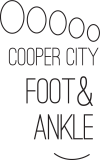Tailor’s Bunion
A tailor’s bunion is a bunion which occurs on the little toe where the metatarsal bone meets the little toe. It is often referred to as a bunionette. Whilst sounding quaint it is no less painful than its big toe cousin. It is a deformity caused when the head of the metatarsal is pushed outwards, protruding from the side of the foot. More precisely tailor’s bunions occur at the metatarsophalangeal joint of the fifth metatarsal bone. They are often swollen and painful.
A tailor’s bunion displays the same symptoms and has similar causes to a bunion on the big toe. Thev feature an enlarged area to the side of the joint facing outwards. The bump is caused bv the displacement of the head of the metatarsal bone, with the accompanying formation of new bone. A” the joint gets larger, it ean be the cause of chronic pain and can become sore, inflamed and tender. Sometimes there is an accompanving lesion which can become infected. The lesion is eased by the abrasion resulting from wearing shoes. Sometimes the bunion can become additionallv swollen if the bursa, a fluid filled membrane around thejoint, becomes inflamed. This is often referred to as bursitis, and usuallv requires anti-inflammatorv drugs to ease the pain.
A tailor’s bunion is so called because it was a frequent ailment in the clothing industrv. Manv hours spent in a cross-legged position on hard floors whilst making clothes resulted in the development of this condition. When sitting cross-legged, the weight of the legs is placed on the eontact points, such as the ioint of the little toe. Over time the little toe started to bend inwards and hone to protrude outwards, often ‘,1th a considerable degree of bunion pain. Tailors bunions occur mainlv due to wearing inappropriate footwear where the toes are cramped in a small toe box. The problem is exacerbated by modern inflexible synthetic materials often found in cheap high heeled shoes. Fashion has dictated that women wear high heeled dainty shoes which to place their feet under undue stress, and it is the reason whv the majority of cases are with female patient’S.
What compounds the problem is an excessively elevated heel as is found in stilettos. When the heel of the foot is raised, the weight of the body shifts almost entirely onto the ball of the feet and thc toes. The additional pressure against the side of the shoes, and the pressUl’C exerted on the joints cause the deformity. Over time the metatarsal bone moves and the bunion develops.
Bunions can occur on both sides of the feet and depending on the gait sufferers find that they are more prone to a certain type. One of the most common complaints with people who have wide feet is the Tailors bunion, as many people with more vidth to their feet often still wear standard shoes vhich place the sides of the feet, especially the toe ioints, under adverse pressure.
The problem is curable, either through a range of home administered treatmenls or by having a tailor’s bunionectomv, the surgical procedure ‘which removed excess bone grovvth and repositions the small toe. Bunion pain can be cased with over the counter anti-inflammatory drugs and painkillers; however with prolonged chronic pain the doctor mav consider surgerv as the best course of action.
